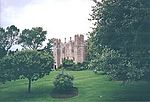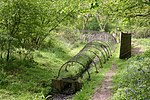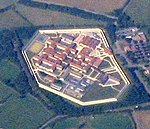Stoke Common

Stoke Common is an 83.1-hectare (205-acre) Site of Special Scientific Interest in Stoke Poges in Buckinghamshire. It is registered common land, and it is owned by a charitable trust, with the City of London Corporation as the main funder and trustee.The site is a last remnant of a large heath, and is on glacial gravel over London clay, with some parts permanently waterlogged. Periodic burning helps to manage the land. There are small areas of birch, pine and mixed woodland, with several ponds. There is a rich invertebrate fauna, especially moths, and the dusky cockroach and rare bog bush cricket have also been recorded.There is access from Stoke Common Road and Gerrards Cross Road.
Excerpt from the Wikipedia article Stoke Common (License: CC BY-SA 3.0, Authors, Images).Stoke Common
B4011, Cherwell District Piddington
Geographical coordinates (GPS) Address Nearby Places Show on map
Geographical coordinates (GPS)
| Latitude | Longitude |
|---|---|
| N 51.833099 ° | E -1.071889 ° |
Address
B4011
HP18 9UY Cherwell District, Piddington
England, United Kingdom
Open on Google Maps








